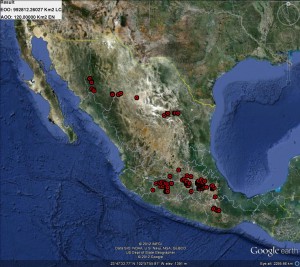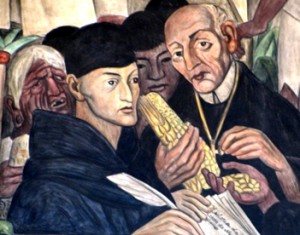- A Population Genomics Perspective on the Emergence and Adaptation of New Plant Pathogens in Agro-Ecosystems. Crop diversity affects fungal diversity as much as the other way around. Actually more so, as fungal genomes are incredibly plastic.
- Teosinte as a model system for population and ecological genomics. Genetics of speciation, hybridization, various evolutionary questions: all can usefully be looked at in the maize-teosinte system with cheap next-generation sequencing. Oh, and that can help us with crop improvement.
- Does organic farming reduce environmental impacts? –- A meta-analysis of European research. Per unit area, yes. Per unit product, not always. Need to mix and match. Good luck with that.
- “Healthy,” “diet,” or “hedonic”. How nutrition claims affect food-related perceptions and intake? If you tell people something is healthier, they believe it is, in fact, well, healthier.
- Guanaco management by pastoralists in the Southern Andes. They can coexist with cattle.
- Earthworms promote the reduction of Fusarium biomass and deoxynivalenol content in wheat straw under field conditions. Earthworms protect crops from pathogens.
- Screening of pea germplasm for resistance to powdery mildew. 14 accessions from 10 countries are promising. That’s out of 700. Hard row to hoe.
- Sources of high tolerance to salinity in pea (Pisum sativum L.). Out of some 780 accessions, China seems to be a hotspot, but the most tolerant accession was from Greece. Any overlap with the previous results?
- A rare case of natural regeneration in butternut, a threatened forest tree, is parent and space limited. In situ is not enough. Not if you don’t help it along, anyway.
- Relationship between survival and yield related traits in Solanum pimpinellifolium under salt stress. 2 accessions among a subset of over 90 from over 300 in the AVRDC collection show high survival and yield under stress. Would be interesting to know if the 90 were indeed well-chosen in the first place.
- Climate warming could shift the timing of seed germination in alpine plants. Spring emergence will shift to autumn, but the bad effect will be on the seedlings.
- Medieval emergence of sweet melons, Cucumis melo (Cucurbitaceae). Lexicography suggests that there were sweet melons in Central Asia early on, but they didn’t get to Iberia until the late 11th Century, and to the rest of Europe until the 15th. Climate and the clash of civilizations to blame, as ever.
- Tibet is one of the centers of domestication of cultivated barley. The other being the Fertile Crescent. Some Chinese hulless and six-rowed barleys in particular are similar to Tibetan wild material. But are the authors stretching the data?
- A map of rice genome variation reveals the origin of cultivated rice. Or origins. Japonica first domesticated from O. rufipogon in the middle Pearl River in Southern China, and indica is a hybrid of the first cultivars with local wild rice in South East and South Asia. But have we not heard this before? Ah, but this paper has more, better markers, no doubt. Anyway, compare and contrast with maize and barley above.
- Lessons on the relationship between livestock husbandry and biodiversity from the Kenya Long-term Exclosure Experiment (KLEE). Livestock and wildlife can coexist, but you have to work at it. Bit like the guanaco thing, then?
- Modeling plant species distributions under future climates: how fine-scale do climate projections need to be? Doesn’t matter for total extent, but actual locations of stable climates vary with scale. On average, “270 m is fine enough,” but it really depends on the species. Probably safest answer is “as fine as possible.”
- Fertilisers and insect herbivores: a meta-analysis. Fertilizers good for insect numbers. Which means bad for plants? But insect diversity? Wonder what they do to those earthworms and fungi above…
Nibbles: Cacao breeding, Specialy crops, Taihu pigs
- Breeding cacao in Ecuador.
- Supporting specialty crops in the US.
- Tasty Chinese piglets.
Sacramental varieties
 The CIMMYT genebank holds about 13,000 wheat lines (from a couple hundred populations) from Mexico that they call “sacramental wheats.” This collection was put together by the late Bent Skovmand, who established the CIMMYT genebank back in the 1970s. Sometimes collected in monasteries and cemeteries, and generally restricted to the fringes of cultivated zones, these mainly spring bread wheats are the remnants of the varieties introduced by the Spanish into the New World. You can see the collecting sites in the map above right. They were brought across the Atlantic both to provide familiar food, but also to make the sacramental bread used for Holy Communion. An excellent book relating this history is “Que vivan los tamales! Food and the making of Mexican identity” by Jeffrey M. Pilcher.
The CIMMYT genebank holds about 13,000 wheat lines (from a couple hundred populations) from Mexico that they call “sacramental wheats.” This collection was put together by the late Bent Skovmand, who established the CIMMYT genebank back in the 1970s. Sometimes collected in monasteries and cemeteries, and generally restricted to the fringes of cultivated zones, these mainly spring bread wheats are the remnants of the varieties introduced by the Spanish into the New World. You can see the collecting sites in the map above right. They were brought across the Atlantic both to provide familiar food, but also to make the sacramental bread used for Holy Communion. An excellent book relating this history is “Que vivan los tamales! Food and the making of Mexican identity” by Jeffrey M. Pilcher.
 Here’s my question. Are there some varieties that would have been used only for Holy Communion? I’ve heard it said that this was the case for grape varieties and sacramental wine, although I can find no evidence online for that, or indeed for purely sacramental bread wheat varieties. So I’m turning to the wisdom of the crowd. That means you. Are you aware of any wheat or grape varieties that are (or were) used solely (or mainly, let’s give ourselves some room for maneuver here) to produce sacramental bread or wine for the Eucharist? Or do you know someone who might know? Either way, leave us a comment, please.
Here’s my question. Are there some varieties that would have been used only for Holy Communion? I’ve heard it said that this was the case for grape varieties and sacramental wine, although I can find no evidence online for that, or indeed for purely sacramental bread wheat varieties. So I’m turning to the wisdom of the crowd. That means you. Are you aware of any wheat or grape varieties that are (or were) used solely (or mainly, let’s give ourselves some room for maneuver here) to produce sacramental bread or wine for the Eucharist? Or do you know someone who might know? Either way, leave us a comment, please.
Nibbles: Darwin herbarium, Saving seeds, Hunger Season, Grafting, Farmers’ rights, Vitamin A scandal, Plant hunting
- Did you know Darwin collected crop wild relative specimens on the Beagle?
- Saving the Running Conch. And its stories.
- Melinda Gates plugs “Hunger Season.” Including to AGRA, presumably.
- I want a fruit salad tree too.
- If you know how to implement Farmers’ Rights, the ITPGRFA would like to hear from you.
- Don’t keep taking the (vitamin A) pills.
- Hunters, pirates. You pays your money…
Nibbles: Diversification talk, Gene award, Community genebanks, GCARD, Natural products, Nutrition talk, Wild bees, GM for drought fail, Face of breeding, Cheese, Bird, Cacao smuggling, CWRs, Perreniation
- ICRISAT DG agrees with Bioversity DG. Kinda. CGIAR DGs communicating via blog. Who’d have thunk it.
- Borlaug Global Rust Initiative gives its first Gene Stewardship Award to Nepali breeders. I wonder if they work with community genebanks at all. Or what they think about them. Or even if they know they are there.
- GCARD 2 is coming, socially networked up the wazoo. Be afraid.
- Authenticating natural health products via barcoding.
- FAO discussion on making agriculture work for nutrition.
- Nice photos of wild bees.
- Not sure if we already linked to the big report on why biotechnology is not delivering drought-resistant crops.
- Meet a Breeder. Conventional, natch.
- Who moved my artisanal cheese?
- Bird diversity on intensive farms like happy Tolstoyan familes: the same everywhere.
- What’s a poor cacao farmer to do? Obey the law and make a loss, or break it in the hope of breaking even?
- Kew does the crop wild relatives thing for Plantwise, and check out that picture!
- Nature discovers perreniation as salvation of African soils; can resilieficiency be far behind?